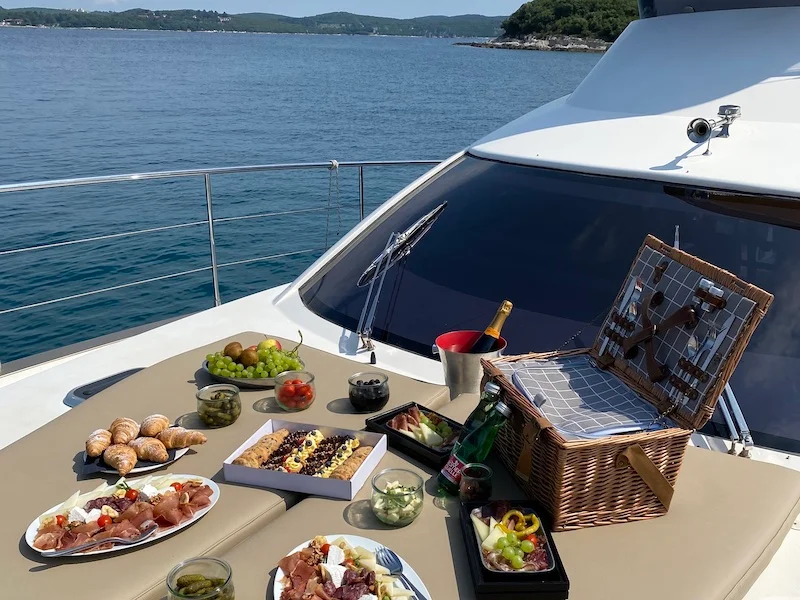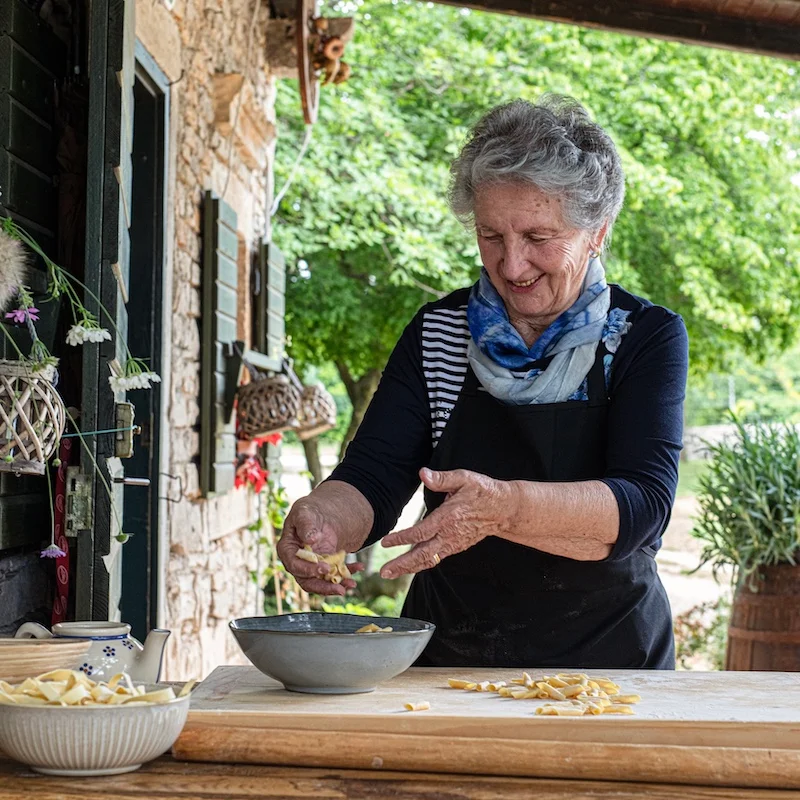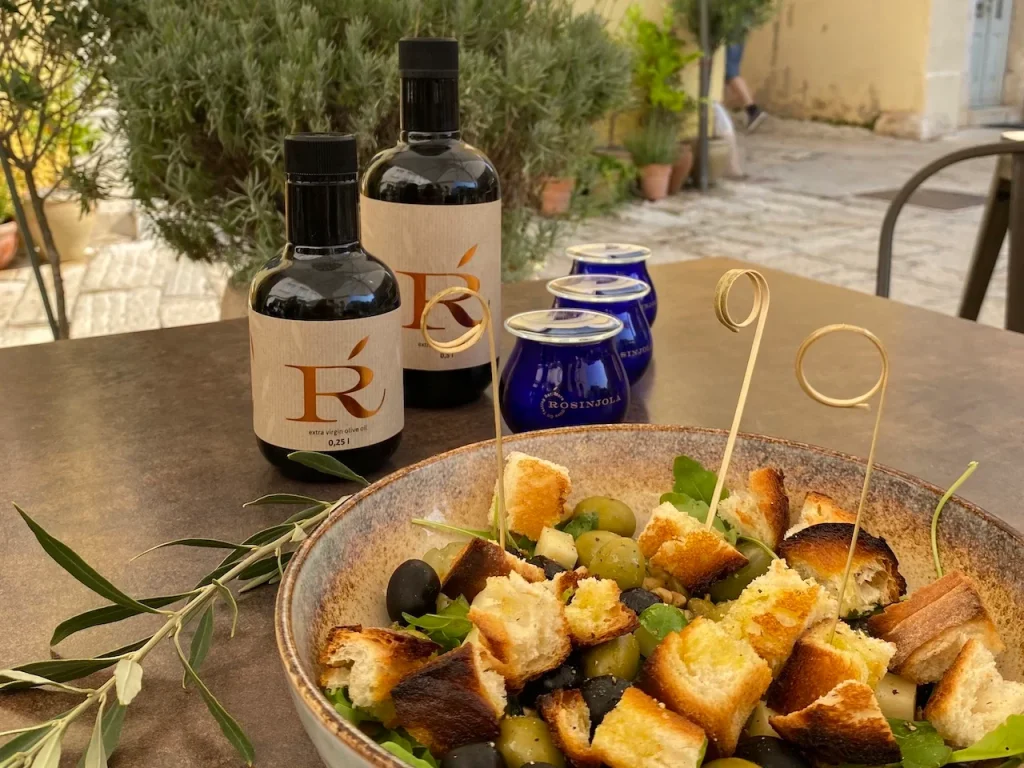There are many beautiful towns and villages to discover in Istria. Whether busy coastal towns or romantic mountain villages – every place is unique! The following list is a personal recommendation.
Bale
Bale is a little hidden gem of Istria! The town is situated on a hill surrounded by vineyards and olive groves. During a walk through the winding old town, you will be completely taken in by the medieval and Mediterranean atmosphere. Stroll at during a day tour past picturesque stone houses, quaint little shops selling art and local produce. The streets form circles around the center of the town with the castle of the Italian family Bembo from the 15th century. In Bale, also called “Valle” in Italian, people not only speak Croatian, but also officially Italian and Istrian. A visit to the crypt of the church and a coffee in the jazz tavern ”Kamene Price” Should not be missed!
Vrsar
One of the most beautiful walks is through the small fisher town Vrsar, which is close to the Limfjord (Lim Bay). The fairytale small town consists of many colorful winding streets, small cafes and boutiques. Let yourself be guided by the narrow alleys to the famous viewpoints. Once here you can enjoy a breathtaking view over the harbor and the archipelago of Vrsar. A guided city walk with some delicious ice cream along the palm-lined promenade is also recommended! You will quickly notice that in Vrsar are many sculptures made of Istrian stone in various corners: parks, viewpoints, bollards or even in the middle of a roundabout. Over 150 sculptures are hidden in the small town! In Vrsar, there is an annual sculpture school in the old quarry. The finished sculptures are exhibited in the city. That means we can look forward to even more great sculptures!
Groznjan
Groznjan was already settled as a fortress by the ancient Romans, which is evidenced by numerous archaeological finds such as mosaic fragments, gold coins and tools. Today’s cityscape is mainly characterized by the Middle Ages. Surrounded by a city wall, Groznjan originally had two city gates, today one of them is left and welcomes people to the small artists’ town. In the 1960s, large parts of the village of Groznjan were decayed and abandoned. However, the city was revived by a few artists who settled here. Today, the city of artists convinces with breathtaking views, romantic streets and many small art galleries and boutiques. Furthermore, a jazz festival takes place every year in July, which attracts thousands of music lovers.
Dvigrad & Kanfanar
Dvigrad is much more than just ruins and should not be missed on a day trip through Istria! According to legend, the notorious pirate Henry Morgan hid a great treasure in the old Istrian castle. During his raids in the Caribbean, he amassed a vast treasure. After falling out of favor with the English, he found himself on the run and decided to hide in the Limfjord (Lim Bay) near Vrsar. In order to protect his treasure, he went in search of an ideal hiding place – and found it in the almost deserted city of Dvigrad. Today, the site amazes with its well-preserved ruins of just over 200 buildings. After a visit to Dvigrad, a short detour to Kanfanar is also worthwhile. There are small workshops where you learn to prepare typical Istrian specialties such as Istrian fuzi (pasta). But a visit to a tavern can also be warmly recommended. Be sure to try the homemade fuzi with game goulash!
Zavrsje & Oprtalj
Istria is not only known for its beautiful coastal landscape, but also for many medieval towns with stunning natural scenery. Two of these towns are Zavrsje and Oprtalj, both almost forgotten, although they have a lot to offer both historically and culturally! Both towns reflect Istria’s Italianate past. The charming towns invite you to linger and a walk through the winding streets lets you step into another time.
Motovun
Motovun is a small town on a hill overlooking the Mirna valley. The medieval town, with the Italian name Montana, lies at an altitude of 280 m and is surrounded by green hills. Today, only around 500 people live in the popular Istrian town. According to excavations, the hill was already used as a place of refuge by pre-Roman people. Architecturally, the town is shaped mainly from the time of Venetian rule. A narrow street paved with old stone slabs, the “Gradisol” leads you past many delicatessen shops and taverns, through the old city gates to the lively main square of the city Trg Andrea Antico. The main square is surrounded by many old buildings, the church of Sv. Stjepan and a free-standing bell tower. However, the town not only offers a fascinating history and exceptional views of the hinterland of Istria, but is also known as a truffle and wine region. It is therefore recommended to choose a nice konoba after a nice walk around the city wall and taste delicious truffle specialties. Afterwards, a visit to a winery is worthwhile: Here you can once again enjoy the unique ambience of the region and taste excellent wines.
Porec
The beautiful seaside town of Porec is located on the west coast of the Croatian peninsula Istria. The history of the city begins in ancient times, when the ancient Romans founded what was then the colony of Parentium. Even today, the many ancient architectural structures inspire visitors and locals alike. So you can not only stroll through the ruins of the former Neptune Temple, but also visit the unique Byzantine Euphrasian Basilica. There you will still find fragments of mosaics from the 4th century and numerous precious sacred works of art. The church itself has remained almost untouched since the 6th century and for this reason it is also protected by UNESCO. The special importance and central location of the basilica are largely responsible for a very special flair in the city.
Hum
With its 30 inhabitants, Hum is known as the “smallest city in the world” and will enchant you during a day trip with its very own charm, flair and enduring traditions. The city is considered one of the most important centers for the old slavic Glagolitic script. This is a very old slavic script that originated in the 9th century and was used until the 19th century. The script became less important as the Latin alphabet became more and more popular. Even today you can find inscriptions and monuments with the Glagolitic script in many places in the city. If you want to learn how to write in the Glagolitic script yourself, then the “Aura Museum Hum” can be recommended. Here you can learn more about the script and even send your own postcard in Glagolitic script!
The smallest town in the world not only enchants with its interesting history, but is also known for the Istrian mistletoe brandy – Biska. It was a priest in Hum who made the brandy according to a thousand-year-old Druidic recipe and used it as a medicine against well-known common diseases such as high blood pressure or heart diseases. Sample the “medicine” at the town’s konoba or at the Aura liquor shop. Insider tip: Visit the cemetery church of St. Jerome. Here you will find beautiful 12th-century frescoes, which are a rare example of Byzantine painting in the Istrian region. If you look a little closer, you’ll see over 40 graffiti inscribed in Glagolitic script on the frescoes!
Pula
Pula is the largest and one of the oldest cities in Istria. Like Porec, Pula was also a Roman colony. Numerous ancient buildings can be admired in the center of the city. One of the most famous sights is the Amphitheater of Pula. The arena, affectionately called by the locals, was built in the 1st century when the most famous Roman construction of the time was built – the Colosseum in Rome. Gladiator fights took place in the middle of the amphitheater, the spectators sat on the side stone steps or stood in the gallery. Today the arena is mainly used for festivals, concerts and operas. Tip: instead of visiting the amphitheater during the day, it is worth getting a ticket for an evening event. The atmosphere at a concert in the arena is unique!
Rovinj
Rovinj is one of the most beautiful cities in Croatia and enchants countless visitors every year with its romantic charm and labyrinthine streets. The city, which was formerly located on an island, can look back on a very rich urban history. A must-do is to visit the Church of St. Euphemia. Euphemia was born near present-day Istanbul in the 3rd century to a distinguished family of senators. At a young age, Euphemia embraced Christianity and renounced paganism.
According to legend, she was imprisoned and tortured for this when she was only 16 years old. So it is said that she was hung up by her hair and fixed on a torture wheel. Finally, she was thrown into a pit in the Hippodrome in Constantinople, but neither the lion nor the bear wanted to harm her. Only when the executioner came and stabbed her with a knife did she die. Later, Emperor Constantine built a large church in Constantinople (Istanbul) in her honor.
The sarcophagus remained there until the early 9th century. According to tradition, the sarcophagus disappeared from Constantinople one stormy night and reached the coast of Rovinj, where a boy with his two cows pulled it out of the sea and carried it to the top of the hill.
The town’s inhabitants considered the arrival of the sarcophagus on their shore a miracle, and so St. Euphemia became the patron saint of Rovinj. You can see the sarcophagus in the church. After a long walk through the winding and picturesque streets, it is worth taking a break in one of the many romantic cafes with a breathtaking view. For breakfast or brunch, a visit to Buffet Trevisol is recommended. For cocktails is the unique Valentino Bar the right place to spend a perfect holiday evening right by the sea!





